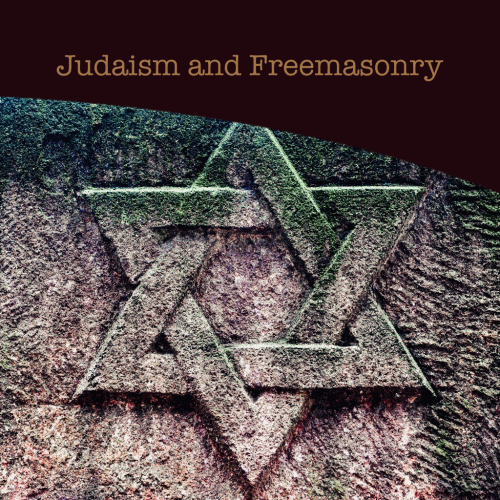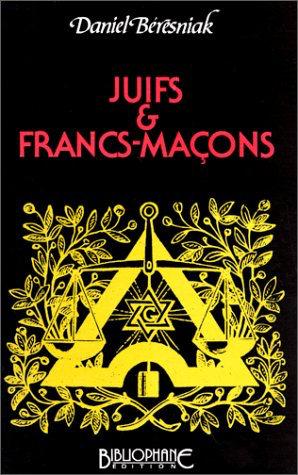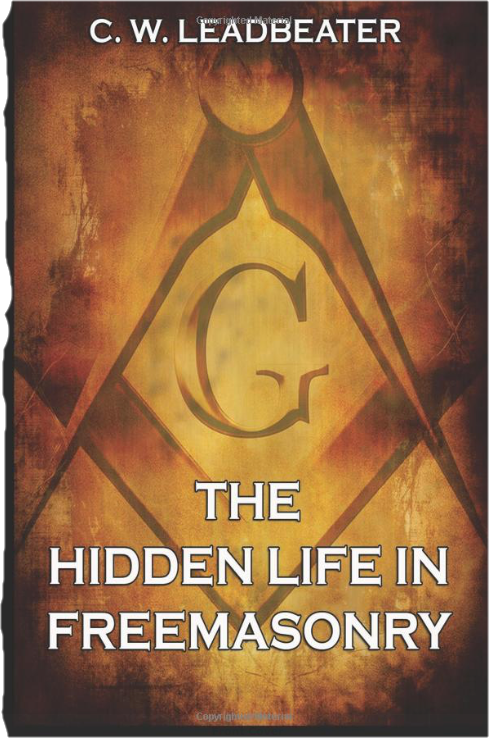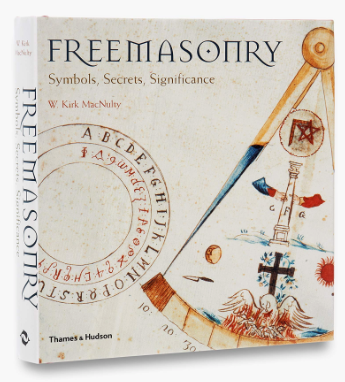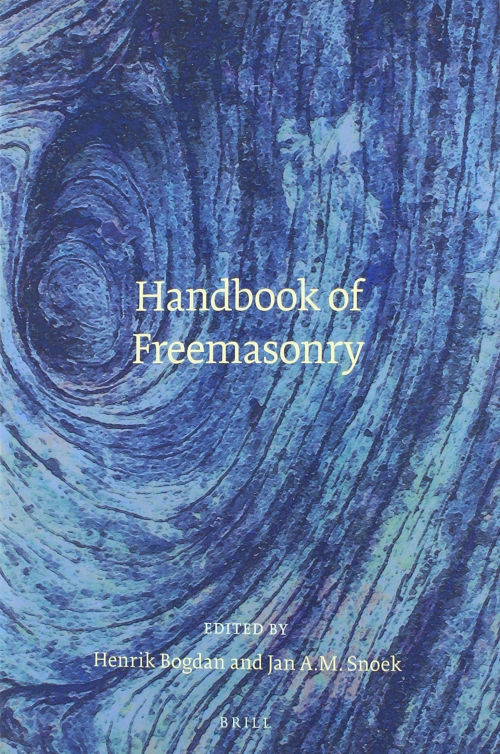The teachings of Freemasonry draw from traditions of biblical and Egyptian antiquity.
Freemasonry today has many facets, and there are many layers of esoteric and exoteric knowledge, that are not always Christian.
Over the centuries, Freemasons have added/integrated other traditions, and intermingled them with Biblical accounts of the Temple of Jerusalem, King Solomon, and other biblical figures

Jesuit Priest Augustin Barruel (1741-1820)
IMAGE LINKED: wikimedia Attribution 4.0 International (CC BY 4.0)
In the latter years of the eighteenth century, a narrative emerged in Catholic Italy and France, which claimed that Jews and Freemasons had joined forces to overthrow the established order of the Throne and the Altar. [1]
In 1791, the Jesuit priest Augustin Barruel fled revolutionary France, and with other conservatives in Britain came to the conclusion that a large conspiracy to establish a sort of anti-Monarchic and anti-Catholic political system in Europe had been designed by Jews and Freemasons.
This fantasy of a Jewish-Masonic conspiracy would flourish during the 19th century and would be at the heart of the Vichy State’s (Régime de Vichy) ideology in the early 1940s, leading to persecutions during the war.
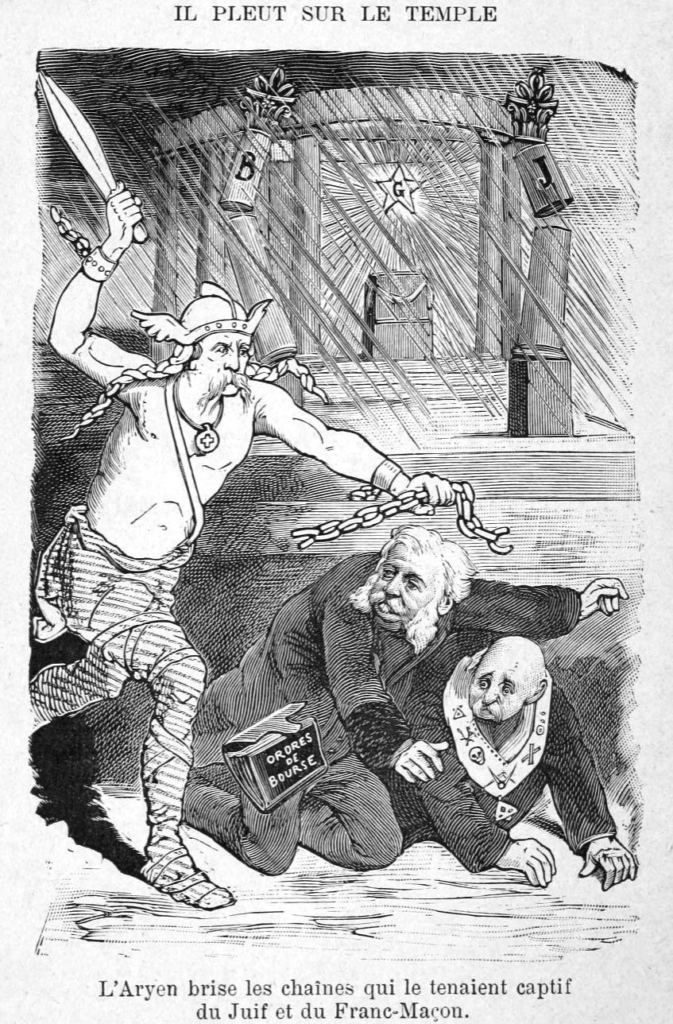
An example of French Anti-Masonic/Anti-Semitic propaganda: “The Aryan breaks the chains of the Jew and the Freemason that held him captive”, drawing of 1897 in a book by Augustin-Joseph Jacquet, in France.
IMAGE LINKED: wikimedia Attribution 4.0 International (CC BY 4.0)
A Jew was initiated for the first time in 1736, in London, and as Daniel Beresniak has described in his book Juifs et Franc-Maçons (Bibliophane, 1989) Freemasonry was a way of Jewish integration in the larger society during the Enlightenment. However, one should not overestimate Freemasonry as a portal to integration.
In his opening sentence of The Hidden Life in Freemasonry, C.W. Leadbeater writes;
‘The origins of Freemasonry are lost in the mist of Antiquity” [2]
In a way, he is right. The teachings of Freemasonry draw from traditions of biblical and Egyptian antiquity.
Freemasonry today has many facets, and there are many layers of esoteric and exoteric knowledge, that are not always Christian.
Over the centuries, Freemasons have added/integrated other traditions, and intermingled them with Biblical accounts of the Temple of Jerusalem, King Solomon, and other biblical figures.
Modern Masonic scholarship came to consider that the essence of Renaissance philosophy – that took place in fourteenth century Italy – was a body of thought which some have called the Hermetic/Cabbalistic tradition.
Revisiting Antiquity, the Renaissance gave birth to this esoteric corpus that made its way in Freemasonry in various forms and teachings. [3]
Among those traditions, the Kabbalah revaluated by Christian authors.
On the other hand, the historical phenomenon of ‘Freemasonry’, even though it has no founder nor founding dates can trace its history back to the 1600s in Britain, at least for its speculative part.
The operative background goes back to the Middle Ages. A distinction must be made between the structure of the lodge and its various rites and content, and the teachings that it conveys.
These two aspects – historical and ideological – are not mutually exclusive, and Freemasonry, as we know it today, is the result of a subtle dynamic between those.
Its diversity in rites, Grand Lodges, and approaches is the result of this evolution. Freemasonry is, in essence, progressive: its core teachings go back to an age-old tradition, or traditions, and its structure – albeit built on common aspects – has evolved and progressed over the centuries.
So, is there a direct link between Judaism and Freemasonry?
The birthplace of modern Freemasonry is seventeenth-eighteenth century Christian Britain; more accurately Protestant Britain.
Operative masonry took roots in medieval Christendom, even though some have made a connection between the construction of the Temple of Jerusalem and the building sites of cathedrals in Europe.
A direct historical link is yet to be proven, although in both cases, the aim was to build God’s abode on earth.
The word ‘Judaism’ describes the religion of the Children of Israel after the destruction of the Temple in 70 C.E. and is often referred to as Rabbinic Judaism.
After this national catastrophe, a Jewish religious group re-invented the biblical religion to operate under new circumstances. There is an element of continuity – the people, the land, the commandments – also creativity: the service of the Temple, so central to Biblical Judaism, became the service of the heart, Torah study, prayer, and acts of good deeds.
The main biblical narratives – the Exodus, the Revelation at Mount Sinai, the forty years in the desert – are at best alluded in Freemasonic rituals, but the centrality of the Temple of Jerusalem, King Solomon, and Hiram, do not belong to the core of Jewish teachings.
The Temple remains in Jewish texts insofar as some Jewish movements are waiting for the Temple to be rebuild when the Messiah comes.
Many parts of the Talmud mention the sacrificial system so as not to forget it, but in Jewish daily practice, the Temple is placed somewhere in the future.
The Hebrew Scriptures – called The Old Testament in a Christian milieu – that are used in Freemasonry are mainly taken from the King James translation of the Bible; a monument of English literature, that shows its original roots.
There was undeniably theological hostility towards Judaism in the seventeenth/eighteenth century, and one of the major tenets of Christian thought was to ascertain that it fulfils and overtakes Judaism.
Can we conclude, with Robert Jan van Pelt, that ‘Rabbinic Judaism had no influence on Freemasonry’, and that ‘the masonic temple and the synagogue stands universes apart’ ? [4]
However we read them, many narratives and characters, and the Temple of Jerusalem, are Jewish in essence.
There is more of course, and some degrees have a clear Christian origin. Nevertheless, the Temple, the columns, the drama take their origin in the first part of the Christian Scriptures.
Like Judaism, Freemasonry is a hermeneutic endeavour. It questions texts of the tradition and attempts to reach a deeper meaning.
In that sense, their methods are identical.
In addition to that, one cannot encompass Judaism with a single definition, as it is also impossible to do so for Freemasonry.
Every religious and spiritual tradition has an esoteric and mystical side that is not always fully accepted.
In Rabbinic Judaism, although it was not necessarily mainstream, some Rabbis have explored the hidden secrets of the Creation of the world, the creative power of letters and words, meditative techniques that help improve the soul.
Some human beings have no taste for initiation, and are satisfied with a structuring religious life, without its mystical aspects.
In other words, one could possibly argue that Judaism is as close to Freemasonry as is Christianity.
The same is true for all other traditions that came along during its long history, and created this unique path of initiation that is at the same time pioneering and encapsulated in an age old tradition that some call ‘the centre of the union’.
Foot Notes
Sources
[1] See Robert Jan van Pelt, ‘Freemasonry and Judaism’, in: Bogdan H. and Snoek Jan A.M., Handbook of Freemasonry, Brill: Leiden, 2017, p. 196.
[2] Reprinted in 2007 by Cornestone Books Publishers, New Orleans, LA. First edition 1925.
[3] See W. Kirk MacNulty, Freemasonry. Symbols, Secrets, Significance, Thames & Hudson: London, 2006, p. 43.
[4] Op. cit. p. 190 & 192.
Article by: Rene Pfertzel
Rene Pfertzel was initiated in 1992 in Lodge Ouverture et Fraternité 1540, in the French Federation of the International Co-Masonry, Le Droit Humain.
After a gap of over 15 years, he re-joined Le Droit Humain in the British Federation, Lodge Hermes 20.
He has a PhD in Biblical Studies, and after a career as a history teacher in France, he retrained to become a Rabbi in London, and stayed in the United Kingdom ever since. He serves a Progressive community in Surrey.
The Hidden Life in Freemasonry
The Masonic fellowship differs from all other societies in that candidates for membership have to join it blindfold, and cannot receive much information about it until they actually enter its ranks.
Even then the majority of Masons usually obtain only the most general idea of the meaning of its ceremonies, and seldom penetrate further than an elementary moral interpretation of its principal symbols.
In this book it is the object, while preserving due secrecy upon those matters which must be kept secret, to explain something of the deeper meaning and purpose of Freemasonry, in the hope of arousing among the Brn. a more profound reverence for that of which they are the custodians and a fuller understanding of the mysteries of the Craft.
Although the book is primarily intended for the instruction of members of the Co-Masonic Order, whose desire, as is expressed in their ritual, is to pour the waters of esoteric knowledge into the Masonic vessels, the author hopes nevertheless that it may appeal to a wider circle, and may perhaps be of use to some of those many Brn. in the masculine Craft who are seeking for a deeper interpretation of Masonic symbolism than is given in the majority of their Lodges, showing them that in the ritual which they know and love so well are enshrined splendid ideals and deep spiritual teachings which are of the most absorbing interest to the student of the inner side of life.
Freemasonry: Symbols,
Secrets, Significance
The ultimate book on Freemasonry, with a rich collection of symbols and lore that illuminate the famous fraternal society.
“The Craft,” with an estimated four million Freemasons worldwide, remains the largest fraternal organization in the world.
Written by an active Freemason, this book comprehensively explains Freemasonry through its fascinating visual culture, rich in mysterious and arcane symbols of life, death, and morality that have evolved over centuries of secrecy and that have profound philosophical meaning.
Ceremonial regalia, paintings, manuscripts, tracing boards, ritual swords, furniture, prints, ephemera, and architecture: the book is copiously illustrated with many specially researched items from Freemasonry archives.
This unrivaled compendium will appeal both to Freemasons wishing to learn the full story of their order and to a general audience that is intensely curious about this traditionally secretive and closed movement.
The coverage includes
- The historical and philosophical background of the order, including the Knights Templar, the medieval stonemasons’ guilds, and esoteric traditions such as Kabbalah and Hermeticism
- Its history from the earliest Masons to the present day, including famous members and scandals
- Its geographical spread from Japan to California, Sweden to South Africa
300 illustrations, 200 in color
Handbook of Freemasonry
(Brill Handbooks on Contemporary Religion)
Freemasonry is the largest, oldest, and most influential secret society in the world.
The Brill Handbook of Freemasonry is a pioneering work that brings together, for the first time, leading scholars on Freemasonry.
The first section covers historical perspectives, such as the origins and early history of Freemasonry.
The second deals with the relationship between Freemasonry and specific religious traditions such as the Catholic Church, Judaism, and Islam.
In the third section, organisational themes, such as the use of rituals, are explored, while the fourth section deals with issues related to society and politics – women, blacks, colonialism, nationalism, and war.
The fifth and final section is devoted to Freemasonry and culture, including music, literature, modern art, architecture and material culture.
Recent Articles: symbolism
 Legends and Symbols in Masonic Instruction Explore the significance of Masonic legends and symbols in this insightful post. Discover how Freemasonry imparts wisdom through allegorical narratives and emblematic imagery, revealing profound moral and philosophical lessons. Unveil the deep connections between Masonic teachings and the broader quest for understanding life’s fundamental questions. |
 Discover the mystical significance of the number 33. From its mathematical marvels and artistic influence in numerology to its esteemed place in Freemasonry, delve into the history and power of this master number. Explore why 33 holds such profound meaning in various spiritual and philosophical traditions. |
 The Practice of Freemasonry - P1 Embark on a transformative journey with Freemasonry, where the exploration of your Center unlocks the Perfect Ashlar within. Through the practices of Brotherly Love, Relief, Truth, and Cardinal Virtues, discover a path of enlightenment and self-improvement. Embrace the universal creed that binds us in the pursuit of our true essence. |
 Discover the fascinating history and significance of the Warrant of Constitution within Freemasonry. Unveil the evolution of this crucial authorization, its role in legitimizing Lodges, and its lasting impact on the global brotherhood of Freemasons. Explore the intricate link it provides between tradition and modern practice. |
 Freemasonry: Unravelling the Complexity of an Influential Organization Mysterious and captivating, Freemasonry has piqued the interest of seekers and skeptics alike. With its intricate blend of politics, esotericism, science, and religion, this enigmatic organization has left an indelible mark on society. Prepare to delve into the secrets of Freemasonry and unlock its hidden depths. |
 Unlocking the Mysteries of Freemasonry: In the hallowed halls of Freemasonry, a powerful symbol lies at the heart of ancient rituals and teachings—the Volume of the Sacred Law. This sacred book not only guides the spiritual and moral journey of Freemasons but also serves as a beacon of universal wisdom and enlightenment. |
 The Ancient Liberal Arts in Freemasonry Embark on a journey of self-improvement and wisdom with Freemasonry's guiding principles. Ascend the winding stairs of moral cultivation, analytical reasoning, and philosophical understanding. Embrace arithmetic's mystical properties and geometry's universal truths. Let the harmony of the universe inspire unity and growth. Discover the profound, hidden knowledge in Freemasonry's path to enlightenment. |
 Initiation rituals around the world are filled with fascinating elements and different images. One of them is that of darkness. When societies speak of darkness, they often mean a lack of knowledge, a lack of choice, or a symbol of evil. During initiation rituals, darkness is used to represent the initiate's lack of knowledge about the world, society, and initiation in general. It can also represent the initiate's inability to make a choice or endure a situation. Whether you have participated in an initiation rite or not, the meaning of darkness remains an intriguing concept worth exploring. Initiation rituals around the world are filled with fascinating elements and different images. One of them is that of darkness. When societies speak of darkness, they often mean a lack of knowledge, a lack of choice, or a symbol of evil. During initiation rituals, darkness is used to represent the initiate's lack of knowledge about the world, society, and initiation in general. It can also represent the initiate's inability to make a choice or endure a situation. Whether you have participated in an initiation rite or not, the meaning of darkness remains an intriguing concept worth exploring. |
 Masonic Deacon rods potentially trace their origins to Greek antiquity, symbolically linked to Hermes' caduceus. As Hermes bridged gods and mortals with messages, so do Masonic Deacons within the lodge, reinforcing their roles through ancient emblems. This connection underscores a profound narrative, weaving the fabric of Masonic rites with the threads of mythological heritage, suggesting the rods are not mere tools but bearers of deeper, sacred meanings that resonate with the guardianship and communicative essence of their divine counterpart, Hermes, reflecting a timeless lineage from myth to Masonic tradition. |
 The biblical pillars erected by Solomon at the Temple's porch, hold a profound place in history. These brass behemoths are not mere decorations; they are symbols of strength, establishment, and divine guidance. Explore their fascinating construction, dimensions, and the deep meanings they carry in both biblical and Masonic contexts. |
 Unlocking the Mind's Potential: Dive deep into ground breaking research revealing how simple daily habits can supercharge cognitive abilities. Discover the untapped power within and redefine your limits. Join us on this enlightening journey and transform your world! |
 Dive deep into the symbolic importance of the trowel in Masonry, representing unity and brotherly love. From its historical roots in operative masonry to its significance in speculative masonry, this article explores the trowel's multifaceted role. Discover its connection to the sword, the story of Nehemiah, and the Society of the Trowel in Renaissance Florence. Unravel the layers of meaning behind this enduring Masonic symbol. |
 Symbolism of The Builder's Jewel Batty Langley's "The Builder’s Jewel" (1741) is a visual masterpiece of Masonic symbolism, showcasing Langley's deep understanding of Freemasonry. The frontispiece highlights key symbols like the three pillars and the legend of Hiram Abiff, emphasizing Langley's dedication to Masonic traditions and teachings. |
 Unveil the mystique of the colour blue in Masonic symbolism. A hue evoking universal friendship and benevolence, its roots span ancient cultures, infusing Freemasonry's core values. This article explores blue's profound significance, guiding Freemasons towards wisdom and spiritual enlightenment. Discover the fascinating journey of this universal symbol. |
 Discover the intriguing world of the plumb in Masonic symbolism with our in-depth analysis. Uncover its rich history, moral teachings, and significance in Freemasonry, guiding members on their path to truth, integrity, and justice. Immerse yourself in the captivating power of this symbol that shapes lives within the brotherhood. |
 Unlock the mysteries of Freemasonry with 'The Key,' a profound Masonic symbol. This seemingly simple instrument holds a deeper meaning, teaching virtues of silence and integrity. Explore its ancient roots, from Sophocles to the mysteries of Isis, and discover how it symbolizes the opening of the heart for judgment. |
 Unlock the secrets of the Freemasonry with The Blazing Star - a symbol that holds immense significance in their rituals and practices. Delve into its history, meaning and role in the different degrees of Freemasonry with expert insights from the Encyclopedia of Freemasonry by Albert Mackey. Discover the mystique of The Blazing Star today! |
 There is no symbol more significant in its meaning, more versatile in its application, or more pervasive throughout the entire Freemasonry system than the triangle. Therefore, an examination of it cannot fail to be interesting to a Masonic student. Extract from Encyclopedia of Freemasonry by Albert Mackey |
 The Hiramic Legend and the Myth of Osiris Hiram Abiff, the chief architect of Solomon’s Temple, is a figure of great importance to Craft Freemasonry, as its legend serves as the foundation of the Third Degree or that of a Master Mason. He is the central figure of an allegory that has the role of teaching the Initiate valuable alchemical lessons. Although his legend is anchored in biblical times, it may have much older roots. |
 This rite of investiture, or the placing upon the aspirant some garment, as an indication of his appropriate preparation for the ceremonies in which he was about to engage, prevailed in all the ancient initiations. Extract from The Symbolism of Freemasonry by Albert G. Mackey |
 The All-Seeing Eye of God, also known as the Eye of Providence, is a representation of the divine providence in which the eye of God watches over humanity. It frequently portrays an eye that is enclosed in a triangle and surrounded by rays of light or splendour. |
 What's in a Word, Sign or Token? Why do Freemasons use passwords, signs, and tokens? As Freemasons we know and understand the passwords, signs and tokens (including grips), which are all used a mode of recognition between members of the fraternity. |
 A Temple of Living Stones: Examining the Concept of a Chain of Union What are the origins of the Chain of Union? And how did they come about ? The answers may surprise some members as W Brother Andrew Hammer investigates, author of Observing the Craft: The Pursuit of Excellence in Masonic Labour and Observance. |
 One of the best loved stories for the festive season is ‘A Christmas Carol’. A traditional ghost story for retelling around the fire on a cold Christmas Eve, it is a timeless classic beloved by those from all walks of life. Philippa explores the masonic allegory connections… |
 The Trowel - Working Tool of the Master Mason The Trowel is the symbol of that which has power to bind men together – the cement is brotherhood and fellowship. |
 Two Perpendicular Parallel Lines The point within a circle embordered by two perpendicular parallel lines, with the Holy Bible resting on the circle, is one of the most recognizable symbols in Freemasonry. It is also one which always raises a question. How can two lines be both perpendicular and parallel? |
 "The first great duty, not only of every lodge, but of every Mason, is to see that the landmarks of the Order shall never be impaired." — Albert Mackey (1856) |
 It is common knowledge that the ancient wages of a Fellowcraft Mason consisted of corn, wine, and oil. |
 “Do not come any closer,” God said. “Take off your sandals, for the place where you are standing is holy ground.” Exodus 3:5 |
 The Secret Language of the Stone Masons We know of Masons' Marks but lesser known are the 'argots' used by the artisans - in part 2 of a series on the social history of the Operative Masons we learn how the use of secret languages added to the mystery of the Guilds. |
 The phrase appears in the Regius Poem. It is customary in contemporary English to end prayers with a hearty “Amen,” a word meaning “So be it.” It is a Latin word derived from the Hebrew word - Short Talk Bulletin - Vol. V June, 1927, No.6 |
 Egypt's 'Place of Truth' - The First Operative Stone Masons' Guild? Was ancient Egypt's 'village of the artisans' the first operative stone masons' guild? And was their use of 'identity marks' a forerunner of the Mason's Marks of the cathedral builders of the Middle Ages? Read on for some possible answers… |
 The Pieces of Architecture and the Origin of Masonic Study Discover the journey of the Apprentice – from Operative to Speculative. This journey has been carried out since the times of operative Freemasonry but today the initiate works in the construction of his inner temple. |
 The Builders' Rites - laying the foundations operatively and speculatively The cornerstone (also ‘foundation’ or ‘setting’ stone) is the first stone to be set in the construction of the foundations of a building; every other stone is set in reference to this. |
 Applying the working tools to achieve our peculiar system of morality. |
 We take an in-depth look at the 47th Proposition of the 1st Book of Euclid as part of the jewel of the Past Master. |
 The Cable Tow: Its Origins, Symbolism, & Significance for Freemasons - Unbinding the significance of the cable tow. |
 We examine at one of the most impressive moments of the initiatory ceremony, a certain rite known as Circumambulation, and ask what is its meaning and purpose ? |
 So, what is the Level? And why do we use it in Freemasonry? |
 What is the mysterious pigpen or Masonic cipher that has been used for centuries to hide secrets and rituals? |
 The Story of the Royal Arch - The Mark Degree Extracted from William Harvey's 'The Story of the Royal Arch' - Part 1 describes the Mark Degree, including the Working Tools. |
 Ashlars - Rough, Smooth - Story of a Stone How we can apply the rough and smooth Ashlars with-in a masonic context |
 A detailed look at the Chamber of Reflection: A Revitalized and Misunderstood Masonic Practice. |
 Exploring the origin and symbolism of Faith, Hope and Charity |
 The Noachite Legend and the Craft What is it to be a true Noachidae, and what is the Noachite Legend and the Craft ? |
 In Masonic rituals, Jacob’s ladder is understood as a stairway, a passage from this world to the Heavens. |
 What is the meaning of the Acacia and where did it originate ? |
 What is the connection with the Feasts of St John and Freemasonry |
 The Forget-Me-Not and the Poppy - two symbols to remind us to 'never forget' those who died during the two World Wars. |
 Biblical history surrounding the two pillars that stood at the entrance to King Solomon's Temple |
 Is there a direct link between Judaism and Freemasonry? |
 The symbolism of the beehive in Masonry and its association with omphalos stones and the sacred feminine. |
 The Wages of an Entered Apprentice |
 An explanation of the North East corner charge which explores beyond one meaning Charity - |
 A brief look at the origins of the two headed eagle, probably the most ornamental and most ostentatious feature of the Supreme Council 33rd Degree Ancient and Accepted (Scottish ) Rite |
 A Muslim is reminded of his universal duties just as a Freemason. A Masonic Interpretation of the Quran's First Two Chapters |
 The three Latin words -{Listen, Observe, Be Silent}. A good moto for the wise freemason |
masonic knowledge
to be a better citizen of the world
share the square with two brothers

click image to open email app on mobile device



